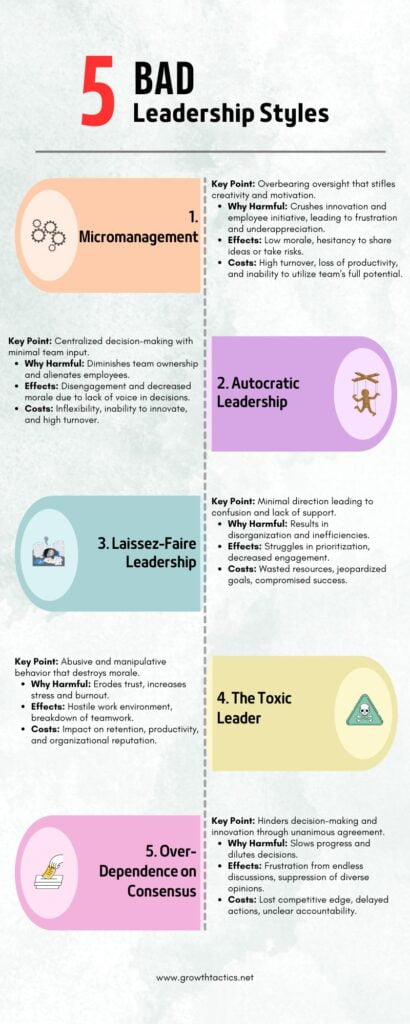Leadership can make or break an organization. I’ve witnessed remarkable turnarounds when effective leadership is in place, teams thrive, productivity soars, and morale boosts. Conversely, I’ve seen how poor leadership can tear apart the fabric of a company, leading to dwindling motivation and high turnover. It’s crucial to recognize and steer clear of detrimental leadership styles to ensure your team’s success. This article explores five bad leadership styles to avoid that could be sabotaging your team, and how avoiding them can transform your workplace.

Jump To Section
1. Micromanagement
Have you ever felt the stifling presence of a supervisor hovering over your shoulder, critiquing every detail of your work? That’s micromanagement in action. A leadership style that tells team members they’re not trusted to make decisions or manage their tasks. Micromanagers are notorious for demanding constant updates and refusing to delegate effectively, leading to a climate of frustration and a sense of underappreciation among employees.
Why It’s Harmful: Micromanaging can suffocate innovation and crush the initiative. If leaders don’t give team members space to breathe or trust them to operate independently, their motivation plummets. Robotic adherence to processes, often not aligned with the team’s potential, replaces the creativity that fuels growth and problem-solving.
Effects on the Team: Micromanaged employees may feel undervalued and overlooked, resulting in lower morale. They’re less likely to take ownership of their work, knowing that scrutiny follows their every move. This can create an environment where individuals are hesitant to share ideas or take risks, ultimately stifling the team’s development.
The Costs: In addition to damaging confidence and creativity, micromanagement can lead to higher turnover rates. Talented team members who feel stifled are more likely to seek out organizations that will trust them and value their contributions. The result? A constant cycle of training new hires, loss of company knowledge, and a dip in overall productivity.
Micromanagement doesn’t just hinder the growth of team members, it can also keep the whole team from reaching its true potential. By stepping back and trusting your team, you allow them to harness their strengths and contribute more effectively to the organization’s success.

2. Autocratic Leadership
Autocratic leadership is characterized by individual control over all decisions, with little to no input from team members. This is often not an effective leadership style. Leaders who adopt this style often make choices based on their judgments and ideas, without consulting those who will be affected by their decisions.
Why It’s Harmful: This top-down approach can stifle the sense of ownership and responsibility among team members. Autocratic leadership discourages collaboration and can alienate employees, making them feel that they have no voice or stake in the team’s outcomes. Such an environment is not conducive to open communication or team cohesion.
Effects on the Team: When decisions are made unilaterally, team members may feel undervalued and disconnected. This often leads to a lack of engagement and a decrease in morale among employees. Without the freedom to express their opinions or contribute to decision-making, team members can quickly lose motivation and passion for their work.
The Costs: Autocratic leadership can result in a rigid, inflexible work environment that fails to adapt to change, innovate, or harness the collective expertise of its members. It can create a culture of dependency, where employees wait for directions instead of proactively addressing challenges. Furthermore, such a leadership style can lead to a high turnover rate, as employees often leave in search of more collaborative and respectful workplaces.
By learning to delegate authority and involve team members in the decision-making process, leaders can foster a more dynamic, resilient, and responsive team. This collaborative approach not only enhances morale but also leverages the diverse talents and insights of all employees, leading to better outcomes and a more positive workplace culture.
3. Laissez-Faire Leadership
A stark contrast to autocratic leadership, laissez-faire leadership is where leaders take a hands-off approach, providing minimal direction and allowing team members to make decisions independently. While this style champions autonomy, it can sometimes translate to a lack of guidance and support.
Why It’s Harmful: Laissez-faire leadership can be problematic when it fosters an environment of confusion and disorganization. Without clear direction or expectations, team members may struggle to prioritize tasks, meet deadlines, and achieve goals. It’s crucial for teams to have enough structure to operate efficiently, and too little oversight can hinder their ability to do so.
Effects on the Team: Although self-motivated employees may thrive under laissez-faire leadership, it can be demoralizing for those who rely on clear directives and feedback to perform their jobs effectively. Team members may feel neglected or unsupported, leading to disengagement and a sense that leadership is disinterested in their work and progress.
The Costs: With inadequate leadership, projects and initiatives can stall or head in the wrong direction, resulting in wasted resources and missed opportunities. Lack of accountability can spread, creating a workplace culture where responsibility is abdicated and collective goals are jeopardized. Moreover, the team’s potential for success is compromised when there’s no one to drive the vision forward or align individual efforts with the organization’s objectives.
Effective leaders find a balance between giving their team autonomy and providing the necessary guidance. By setting clear goals and being available to support and direct their team members as needed, leaders can ensure a productive work environment that capitalizes on the strengths and independence of every team member.
4. The Toxic Leader
Toxic leadership goes beyond inefficient management; it represents conduct that can harm an organization’s morale and culture in profound ways. Toxic leaders are often characterized by abusive behavior, manipulation, and a general disregard for the well-being of their teams.
Why It’s Harmful: Toxic leadership can erode trust within a team, destroy morale, and create a hostile work environment. Team members may experience increased levels of stress, burnout, and anxiety due to the constant negativity and pressure. Such leaders may rely on fear or intimidation to achieve results, which can damage employee self-esteem and job satisfaction.
Effects on the Team: Under the influence of toxic leaders, employees often feel undervalued and fearful. The workplace becomes a place of dread, where individuals might compete in unhealthy ways, becoming secretive or isolated to protect themselves. This dynamic can lead to a breakdown of teamwork, poor communication, and a lack of cooperation.
The Costs: Beyond impacting individual employees, toxic leadership can have long-term consequences for the organization, affecting retention rates, productivity, and even public reputation. High turnover becomes costly, and the organization’s ability to attract top talent diminishes as word spreads about its negative culture. Additionally, innovation and creative thinking are stifled, as employees are reluctant to share ideas in a punitive environment.
Addressing toxic leadership involves establishing firm policies against such behaviors, promoting a culture of respect, and creating safe channels for employees to report concerns without fear of reprisal. It requires commitment from the highest levels of an organization to recognize and rectify these damaging patterns. A healthy work environment starts with leaders who exemplify empathy, open communication, and a commitment to the growth and well-being of their teams.
5. Over-Dependence on Consensus
Seeking consensus is often seen as a positive approach to leadership, as it involves consideration of the opinions and perspectives of the entire team. However, an over-dependence on achieving unanimous agreement can lead to its own set of challenges.
Why It’s Harmful: When leaders are too reliant on reaching consensus, decision-making can become painfully slow and ineffective. A fear of conflict or the desire to please everyone may result in watered-down resolutions that satisfy no one. Leaders may avoid making tough calls or delay necessary actions in the hope of getting everyone on board.
Effects on the Team: An over-emphasis on consensus can lead to frustration among team members, particularly when it impedes progress. Some individuals may feel that their time is wasted in endless discussions that yield little results. Additionally, striving for universal agreement might suppress dissenting but valuable opinions that can lead to better, more innovative solutions.
The Costs: Organizations that insist on complete agreement for every decision risk losing competitive edge. Opportunities may be missed due to the inability to act swiftly. Moreover, a reliance on consensus can obscure accountability, as it becomes unclear who is responsible for final decisions. This might result in a lack of direction for the team, causing confusion and misalignment with organizational goals.
Leaders can mitigate these pitfalls by fostering a culture where diverse viewpoints are encouraged and respected, but also by having the willingness to make executive decisions when necessary. Balancing consensus-building with decisive action is critical for maintaining momentum and ensuring the team remains focused and effective. Leaders should strive to listen and incorporate feedback while also guiding their teams with clarity and decisiveness.
Strategies for Cultivating Effective Leadership
Developing effective leadership is crucial for the success and health of an organization. Here are strategies that can help individuals cultivate their leadership skills and foster a productive, positive work environment:
Encourage Open Communication
Create a culture where feedback is valued and encouraged. Establish regular channels for open dialogue, like team meetings or one-on-one sessions, where team members can share ideas and concerns freely without fear of retribution.
Set Clear Objectives
Define clear, achievable goals that align with the organization’s vision. Ensure that each team member understands these goals and their role in accomplishing them. This helps foster a sense of purpose and direction.
Empower Your Team
Give team members the autonomy to make decisions and take ownership of their work. Provide the resources, support, and training they need to succeed. Empowerment instills confidence and encourages innovation.
Lead by Example
Demonstrate the values and behaviors you expect to see in your team. Be accountable for your actions, show integrity, and treat everyone with respect. Leading by example sets a powerful benchmark for the team.
Balance Autonomy and Guidance
While autonomy is vital, so is guidance. Be willing to step in when necessary to provide direction, ensure alignment with objectives, and help the team overcome obstacles.
Recognize and Reward Contributions
Acknowledge individual and team achievements. Celebrate successes and reward efforts that contribute positively to the organization’s goals, which can boost motivation and loyalty.
Facilitate Professional Development
Invest in the growth of your team members through training, mentoring, and opportunities for career advancement. Supporting their professional development shows that you value their contributions and are invested in their future.
Manage Conflict Constructively
Do not avoid conflict; instead, address it in a healthy, constructive manner. Use conflict resolution strategies to mediate disputes and foster an environment where differing viewpoints can lead to growth, not discord.
Cultivate Emotional Intelligence
Develop your emotional intelligence by being mindful of your own emotions and those of others. Respond rather than react, and develop empathy to understand and relate to your team better.
Foster a Positive Work Culture
Create a work environment that is supportive and inclusive. Encourage team-building activities and ensure that each member feels like they belong and are valued.
By implementing these strategies, leaders can develop a leadership style that not only drives performance but also nurtures a collaborative, respectful, and engaging workplace. Leadership is not static but should be constantly refined to meet the evolving needs of the team and the organization.
Conclusion
In conclusion, while recognizing negative leadership styles is an essential step toward organizational health, it’s equally imperative to actively practice positive leadership strategies. As a leader, I encourage you to steer clear of the pitfalls of toxic leadership, indecision, and over-dependence on consensus that can stifle your team’s potential.
Embrace the strategies outlined above to cultivate a leadership style marked by communication, empowerment, and decisiveness. By doing so, you become not just a boss, but a true leader who inspires confidence, fosters innovation, and guides your team toward success. Remember, leadership is a journey of continuous learning and growth, begin yours today, and lead your team to a brighter, more productive future.








